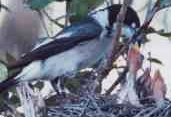Submitted by Gitie on 13 June, 2010 - 00:17
 'How will I tell which bird I am talking to?'' - this is a problem that perplexes many bird lovers.
'How will I tell which bird I am talking to?'' - this is a problem that perplexes many bird lovers.
The human brain faces many challenges in trying to recognise individual birds.
Firstly the birds are much smaller than us which makes their unique features harder for our eyes to spot. Our eyes also cannot see many of the colours in the indigo-violet range unlike the birds who can see many more frequencies of colour than us. To make matters more difficult the smaller birds in particular don't sit still long enough for eyes to get a proper fix on them to be able to notice and learn their individual characteristics.
Our brains need some training and time to get used to the bird patterns. Once we know what to look for it becomes much easier to identify them.
There are 6 easy ways to recognise a bird. Over the next few days we'll cover each of these in more detail.
In today's post we'll look at the first key: Shape, Form and Size.
Every bird is unique regardless of the species. Look at their general shape and size. Try and spot the differences:

Submitted by Gitie on 12 June, 2010 - 00:14

Thornbills (or yellow bottoms as they are fondly called) are barely 5 cms (2 inches) long. The picture on the left was taken with a 300mm zoom. Then the image was digitally enlarged. You get the idea of how small these birds really are against objects in their natural environment.
They first attracted our attention when we were trying to photograph some peewees in a paddock. What appeared to be leaves rolling

Submitted by Gitie on 11 June, 2010 - 00:00

Galahs are also called rose-breasted cockatoos and can be found almost all over Australia. With pretty pink chests and grey coats they strike a stylish figure as they strut about the gum trees. They fly around in pairs and collect in flocks and are extremely social birds.
'Mad as a galah' is a common Aussie saying which probably originated from the fact that they can make loud screechy noises if upset and once they get into this whining state it can take quite a while to calm them down.
There was a time when I too thought they were somewhat crazy. Every night when we took our dogs Scotty and Benny for a walk, one particular galah who should have been fast asleep in his tree high above us and in no danger whatsoever from anything around, would start screeching and wake up the whole neighbourhood in the process.
But Galahs are far from mad. They are very friendly birds. They love showing you their nests and introducing you to their friends and family.

Submitted by Gitie on 9 June, 2010 - 00:00
Our birds have rescued us from snakes on many occasions. Magpies, butcherbirds (both the pied and grey species), noisy-miners and others have all played a part at one time or another in keeping us safe. Most of the time we do not have a camera in hand to capture a photographic record of the event. But on a few occasions we have been lucky enough to be able to do so.

Submitted by Gitie on 8 June, 2010 - 00:00
|

Koels herald the start of the stormy season and are called 'storm birds' by the locals.
While as big as a crow or a currawong, by nature they are shy birds and tend to stay in hiding. Their red eyes match the mulberries in the tree and when they sit in the shade of the broad leaves, one would never guess that there was a big bird sitting only a few feet away.
All the other birds are generally wary of cuckoos as they sense that someone devious is lurking in their midst. The koels know that they are not popular, but they do win favours by chasing the goannas and feral cats thus making friends and gaining the trust with some of the other birds.
Having done so this male koel (left) was allowed to come out of hiding without any protest from the smaller birds that visit our yard. His mind and heart was elsewhere though as we discovered.
|
 In the trees was hiding another male koel whose presence was causing him great consternation. In the trees was hiding another male koel whose presence was causing him great consternation. |
|

It turned out that the tree was hiding another secret. Closer inspection revealed a young female koel who was the centre of attention of the two vying young males. The lady honoured us by coming out after some gentle coaxing and sweet talking.
Her two suitors spent the next few days charming and courting her with their songs. Once she declared her choice they flew into the deep bush leaving one lonely bird who called for weeks. We hope he found his sweetheart too.
Click here for more pics and slideshow
|

Pages

 'How will I tell which bird I am talking to?'' - this is a problem that perplexes many bird lovers.
'How will I tell which bird I am talking to?'' - this is a problem that perplexes many bird lovers. 


 In the trees was hiding another male koel whose presence was causing him great consternation.
In the trees was hiding another male koel whose presence was causing him great consternation.






